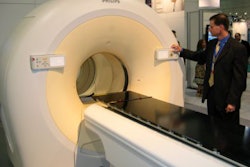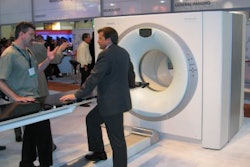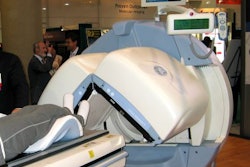SAN DIEGO - Implementing an integrated SPECT/CT system at a facility holds the promise of a very positive clinical impact. However, installation and integration of the technology into the practice workflow can be more than the sum of the hybrid equipment's two modalities, according to a pair of presentations at the Society of Nuclear Medicine (SNM) meeting this week.
"The emergence of the hybrid nuclear camera is changing the face of nuclear medicine," said Shashi Khandekar, a certified nuclear medicine technologist (CNMT) at the Cleveland Clinic in Ohio. "SPECT/CT simplifies patient handling, data acquisition, and co-registration of images. The system has great potential -- it improves diagnostic accuracy, it can perform quantitative functional assessments, and attenuation correction -- but, all this comes with a higher cost."
Khandekar discussed the various elements a facility should consider before buying a hybrid imaging system in her SNM presentation.
The Cleveland Clinic recently installed a Symbia T6 SPECT/CT system (Siemens Medical Solutions, Malvern, PA), and the response from clinicians has been quite positive, she said. The institution located the system in an existing gamma room and kept track of relevant fiscal outlays for the technology before, during, and after its installation.
Beyond the price of the equipment, costs were associated with the adoption and integration of the modality that added to the total expenditure, Khandekar noted.
"Interestingly enough, we realized that the high price tag was only one of the factors that contributed to the increased figure at the bottom line," she said.
Khandekar shared several factors that created incremental costs as a result of SPECT/CT adoption at her hospital:
- Room expansion and modifications resulting in renovation costs
- Separate processing and control area for the technologists resulting in renovation costs
- Radiation protection compliance resulting in additional room shielding costs
- A contrast power injector that resulted in hardware, installation, and integration costs
- CNMT cross-training in CT technology and techniques resulting in time and training costs
- Workflow and scheduling modifications resulting in time costs
- A dual board-certified (radiology and nuclear medicine) physician resulting in professional services costs
Renovating an existing gamma camera space can be tricky, Khandekar said. The sizable equipment can weigh up to 8,500 to 9,000 lb. An institution needs to ensure that the SPECT/CT system can be maneuvered through the facility into an existing space that can support its weight.
In addition, because of the CT elements, the hybrid system can generate a lot more heat than a SPECT gamma camera, so a more powerful environmental control system may need to be installed to keep the room and equipment cool.
Maneuverability within an existing room space should also be mapped out well in advance of installation, Khandekar said. For example, changing collimators is a procedure dependent on the type of exam being conducted. A practice should ensure that there is enough room to maneuver the collimator cart within the space so that such change-outs can be easily done. Also, field engineers will require access to the modality's components, and their needs will want to be taken into consideration -- if only to minimize downtime of the modality during service.
Workflow will also need to be adjusted for the combined modality, Khandekar noted. SPECT procedures at the Cleveland Clinic average approximately 37 minutes, and SPECT/CT procedures are currently averaging approximately 50 minutes. She attributed the 13-minute increase to the CT scan portion of the study, as well as the system's advanced SPECT reconstruction capability. Although this is less time than the two exams would take if performed independently, it does change the routine and timing of the department.
The Cleveland Clinic's nuclear medicine department has put the hybrid system to good use in the 11 months since its July 2005 installation, according to Jeremy Steed, a CNMT at the facility who shared his SPECT/CT clinical experience with SNM attendees. Steed said the system has conducted 830 cases prior to this week's scientific meeting of the society.
The clinic has used the modality for a variety of imaging, including bone scans, brain diamox, brain seizure, cardiac, gallium, liver and spleen, lymphoscintigraphy, iodine-131 meta-iodobenzylguanidine (MIBG), octreotide, parathyroid, ProstaScint, red blood cell (RBC) liver scans, renal, white blood cell (WBC) scans, cerebrospinal fluid (CSF) leaks, and shunt patency studies, Steed said.
"The ability to fuse the molecular and functional SPECT data and anatomical CT data has tremendously impacted the level of patient care," Steed said. "Without the use of SPECT/CT, some cases would have needed additional imaging diagnostic testing or quite possibly may have been overlooked."
Steed noted that SPECT/CT has delivered better image quality that has improved the accuracy of some studies, such as myocardial perfusion, particularly in obese patients. Anatomic localization of lesions has also improved, particularly in cases with limited anatomic resolution with the scintigraphic study. As the interpreting radiologists have increased their use of the modality, their confidence with and in the system has risen, leading to greater utilization of SPECT/CT by referring physicians, he said.
Steed shared that facilities looking to adopt hybrid SPECT/CT should plan on adding an extra 15 to 20 minutes for quality control (QC) each day, for a total of 25 to 30 minutes, as compared with the standard five to 10 minutes for gamma camera-only QC. Also, the schedule for SPECT/CT should incorporate approximately 10 minutes per study for image postprocessing conducted by the systems, he said.
Both Steed and Khandekar stressed that SPECT/CT installation and implementation are unique to each institution, and each practice will need to examine its facility, workflow, and processes to best adapt them for the hybrid technology. In addition, Khandekar recommended that a group considering adding SPECT/CT to its modality mix should take the time to visit a working system.
"Do a site visit and see a unit in operation prior to starting a SPECT/CT project," she advised.
By Jonathan S. Batchelor
AuntMinnie.com staff writer
June 7, 2006
Related Reading
Cardiac SPECT/CT fusion captures SNM's Image of the Year, June 6, 2006
SPECT/CT helps clarify ambiguous bone foci, February 9, 2006
A new use for SPECT/CT: Tracking stem cell migration, October 7, 2005
SPECT/CT pilots prostate brachytherapy in community setting, August 15, 2005
Can SPECT/CT revitalize nuclear medicine? July 7, 2005
Copyright © 2006 AuntMinnie.com



















